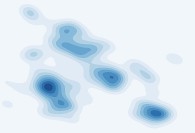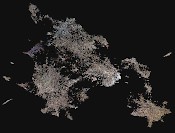The power of AI-driven contextual analysis
Most of the world’s valuable information is unstructured. It exists in the form of texts, images, videos, and audio internally within organizations and externally across the vast digital information universe. It grows rapidly in size: the size of all digitally stored information has doubled in size every second year, and this growth is set to continue.
For the contextual analysis professional, the growth of digital information means that there exists an ever-richer source material to extract insights from. On the other hand, its unstructured nature means a serious challenge when it comes to getting an overview of the information connected to a field of interest. Typical approaches to gaining insights from digital information are using search engines and monitoring tools to search for needles in the haystack. While these approaches do allow interesting observations to be made, they have the disadvantage of being path-dependent and guided by the researcher’s own preconceptions. In other words, researchers find what they are searching for, but do not know what they are missing.
AI enables bottom-up mapping of vast unstructured information
Following progress in the field of artificial intelligence (AI), however, it is now possible to map whole landscapes of digital information by structuring texts and images following a bottom-up approach. Using the AI-generated maps of the digital landscape in a certain field, contextual analysis professionals get both an instant overview of topics and phenomena – including of things they would never have thought of looking for – and a guide to which pieces of information should be in focus for in-depth qualitative study.
The bottom-up approach to contextual analysis is not new; Kairos Future has been following the principle since the start in the early 1990s. However, the approach used to have limitations in terms of scale and what source material could be processed – limitations that the new AI-enabled methods have overcome. A typical bottom-up trend-watching study, for example, used to be a time-consuming process in which a team of analysts read through a sizeable material, such as printed lifestyle magazines and local newspapers, and cut out passages about interesting phenomena. The spottings were then manually clustered by topic on the largest table in a room, which allowed emerging phenomena to be distinguished.
Today’s AI-powered tools allow the same principle to be applied on a much larger scale – enhancing bottom-up contextual analysis in way similar to how digital search engines have improved information search compared the traditional procedures, such as going to the library. There are three main ways in which AI is having an impact on contextual analysis, outlined in more detail below:
- By expanding the domains where insights can be gathered
- By changing how information is searched and processed
- By enabling new ways of disseminating insights
By trawling through vast oceans of publicly available unstructured data, the new approach is able to spot trends and detect emerging phenomena that we ought to know about, even if we had never thought of looking for them. Having tools and processes in place for continuously and effortlessly mapping trends and extracting strategic decision support from the digital information universe is a real competitive advantage and should be a strategic imperative for any organization.
How AI changes the meaning of contextual analysis
1. Expanding the domains where insights can be gathered
Natural language processing has been around for a long time, but it is only recently that it has become justified to call it natural language understanding. New, deep learning-powered techniques are now able to recognize sentiment, emotions, entities, categories, and topics in text with human precision. This enables the structuring and finding insights in news, social media, analyst reports, patents, academic articles, financial reports, and any other text-based information source.
Over a time span of just a few years, AI has also closed the gap between humans and machines when it comes to speech recognition. Translating speech into text enables natural language processing of – and thus extraction of insights from – sources such as customer support calls, podcasts, and all forms of broadcasting.
Partly the same deep learning techniques that have improved speech recognition have also transformed object recognition in images. It is now possible for the contextual analysis professional to organize and make sense of large amounts of image and video data. Use cases include visual trend spotting, brand scan, and market insight based on images published and shared in traditional and social media.
2. Two major shifts in how information is searched and processed
In the information search and collection phase, AI allows a transition from manual and criteria-based search to cognitive and adaptive search. This is made possible by deep learning techniques that understand contextual similarity without being bound by the specific words used, and that revise their own understanding based on user feedback. With the new paradigm, there is no longer a need to set up complex keyword search criteria when searching and monitoring information.
In the data processing and analysis phase, statistical and hypothesis-based approaches are replaced with open-ended and deep learning-powered approaches. The enabler is an AI technique that clusters texts and images into a landscape of meaning, in combination with a visual, interactive way of navigating and exploring this landscape. Effortlessly switching between overview and depth helps the contextual analysis practitioner to interpret and make sense of large amounts of information. It allows us to see the forest and the trees at the same time.


Visual representations of a topic landscape. The image to the right shows a landscape of images that have been clustered based on their content.
3. New ways of disseminating insights
Machines increasingly help contextual analysis professionals with the otherwise time-consuming work of codifying and disseminating insights. Natural language generation can be used to formulate brief texts based on the extracted insights. Automated email alerts and dashboards can be adapted to different roles to keep the organization up to date with important developments.
A rising approach to structuring and storing information in organizations is through knowledge graphs. Relevant information is continuously extracted through various structured and unstructured data sources inside and outside the organization. It is then embedded into the knowledge graph, where it is easily browsed and queried. Structuring information in this way also enables integration with conversational interfaces such as chatbots.
To sum up: redefining what it means to work with contextual analysis
The AI-powered contextual analysis approach is changing the way analysts conduct their work and what they spend their time on. If they traditionally spent 80% of the time on collecting and processing information and the remaining 20% making sense of it and disseminating the insights, these proportions are being flipped with the new, AI-powered paradigm. Rather than defining and revising static information search criteria, contextual analysis professionals are instead teaching deep learning models to capture relevant information. Instead of analyzing data using statistical approaches, they use deep learning to surface interesting patterns and their human knowledge to make sense of them. As an alternative to tedious report writing, they leverage technologies for automatically codifying insights and disseminating them in ways customized for different roles in the organization.
If you want to know more about how your organization can adopt the new approach to contextual analysis, don't hesitate to get in touch with us.
Case: Mapping the startup landscape in China
Covestro (formerly Bayer MaterialScience), a leading global chemicals company, wanted to accelerate its innovation by leveraging external startups in China. We helped them map the entire Chinese startup ecosystem and contextual environment by mining policy documents, news articles, and data on hundreds of thousands of investment deals. We used the next-generation text analytics tool Dcipher Analytics to structure this data and transform it into a network of ownership relationships, which helped Covestro understand the structure and stakeholders of the startup landscape and identify high-potential startups for collaboration. For more insights from the project, read this public report.
If you want to know more about how your organization can adopt the new approach to contextual analysis, don't hesitate to get in touch with us.
